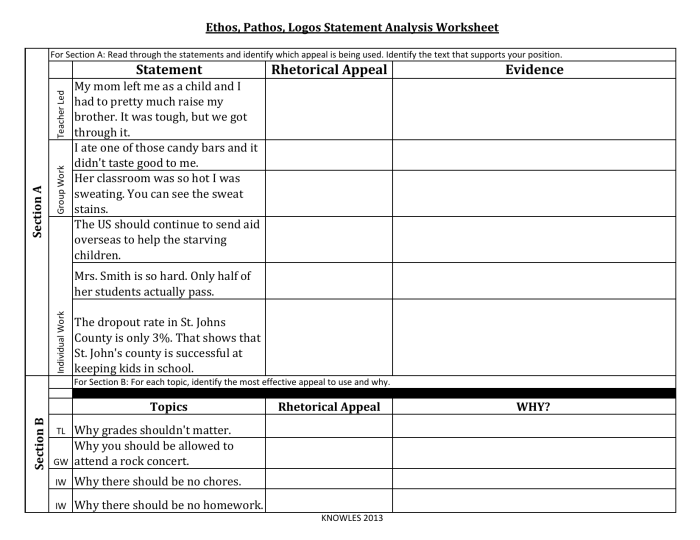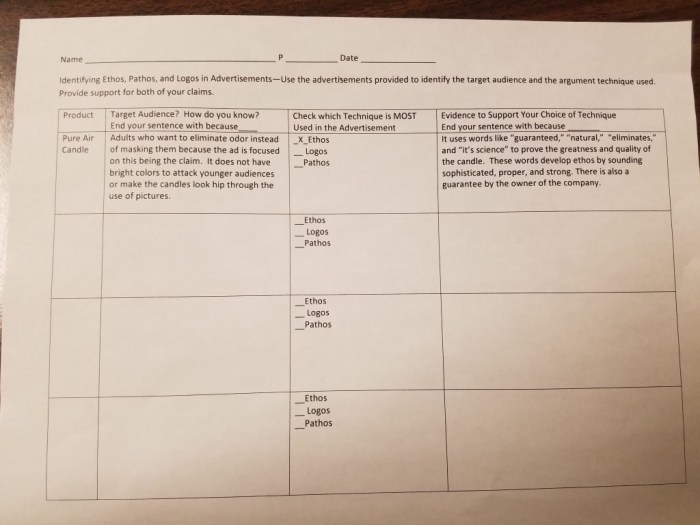Ethos pathos logos worksheet answers – Welcome to the realm of ethos, pathos, and logos worksheet answers, where the art of persuasion unfolds. In this comprehensive guide, we will embark on a journey to unravel the intricacies of these rhetorical devices and explore their profound impact on persuasive writing.
Brace yourself for an illuminating exploration that will empower you to craft compelling arguments and captivate your audience.
As we delve deeper into the subject matter, we will uncover the essence of ethos, the art of establishing credibility and trustworthiness; pathos, the power of evoking emotions; and logos, the compelling force of logical reasoning. Through real-world examples and practical exercises, you will gain a mastery of these persuasive techniques, enabling you to effectively sway opinions and inspire action.
Ethos
Ethos is a Greek term that means “character.” In the context of persuasive writing, ethos refers to the credibility and trustworthiness of the author or speaker. It is one of the three main pillars of persuasion, along with pathos (emotional appeal) and logos (logical appeal).
Ethos is important in persuasive writing because it helps to establish the author’s authority on the topic and build trust with the audience. When an audience trusts the author, they are more likely to be persuaded by the author’s arguments.
Ways to Establish Ethos
There are several ways to establish ethos in writing:
- Demonstrate expertise:Cite credible sources, provide evidence to support your claims, and use technical language to show that you know what you’re talking about.
- Show experience:Share personal stories or anecdotes that demonstrate your firsthand knowledge of the topic.
- Be honest and transparent:Admit when you don’t know something, and correct any errors that you make. This shows that you are credible and trustworthy.
- Use strong language:Use confident and assertive language to show that you believe in what you’re saying.
- Be respectful:Treat your audience with respect, even if you disagree with them. This shows that you are a reasonable and fair-minded person.
Pathos
Pathos is a persuasive technique that appeals to the emotions of the audience. It is an important tool for writers because it can help to create a connection between the writer and the reader, and it can make the reader more likely to agree with the writer’s point of view.
There are many different ways to evoke pathos in writing. Some common methods include:
- Using emotional language
- Telling stories
- Using personal anecdotes
- Citing statistics or facts that support the writer’s point of view
- Using humor
Pathos can be a very effective persuasive technique, but it is important to use it carefully. If the writer uses too much pathos, the reader may become overwhelmed or turned off. Additionally, the writer must be careful not to use pathos in a manipulative way.
Logos

Logos is a persuasive technique that appeals to logic and reason. It presents facts, statistics, and evidence to support an argument. Logos is important in persuasive writing because it helps to establish credibility and build trust with the audience. It can also help to overcome objections and counterarguments.
There are many different types of logical appeals that can be used in persuasive writing. Some of the most common include:
- Deductive reasoning:This type of reasoning uses a general statement to support a specific claim. For example, “All men are mortal. Socrates is a man. Therefore, Socrates is mortal.”
- Inductive reasoning:This type of reasoning uses specific examples to support a general claim. For example, “I have seen three black crows. Therefore, all crows are black.”
- Analogical reasoning:This type of reasoning compares two similar things to make a point. For example, “The human heart is like a pump. Just as a pump needs fuel to function, the human heart needs blood to function.”
- Causal reasoning:This type of reasoning identifies the cause and effect of an event. For example, “The car accident was caused by the driver’s speeding.”
Ethos, Pathos, and Logos Worksheet Answers: Ethos Pathos Logos Worksheet Answers

This worksheet is designed to help you understand the concepts of ethos, pathos, and logos, and how to use them effectively in your writing and speaking.
Ethos, Ethos pathos logos worksheet answers
Ethos is the ethical appeal, which is based on the credibility and trustworthiness of the speaker or writer. To establish ethos, you can:
- Use evidence to support your claims.
- Cite credible sources.
- Demonstrate your expertise on the topic.
- Be honest and transparent.
Pathos
Pathos is the emotional appeal, which is based on the emotions of the audience. To use pathos effectively, you can:
- Use vivid language to create a sensory experience for the audience.
- Tell stories that evoke emotions.
- Use personal anecdotes to connect with the audience.
- Be passionate about your topic.
Logos
Logos is the logical appeal, which is based on the facts and evidence. To use logos effectively, you can:
- Use clear and concise language.
- Provide evidence to support your claims.
- Use logical reasoning to connect your evidence to your claims.
- Be objective and avoid emotional appeals.
Top FAQs
What is the importance of ethos in persuasive writing?
Ethos establishes the writer’s credibility and trustworthiness, making the audience more receptive to their arguments.
How can I effectively evoke pathos in my writing?
Use vivid language, personal anecdotes, and emotional appeals to connect with your audience on a deeper level.
What are the different types of logical appeals used in logos?
Logos encompasses inductive reasoning, deductive reasoning, and statistical evidence to support claims with logical arguments.